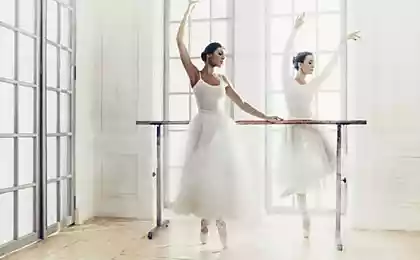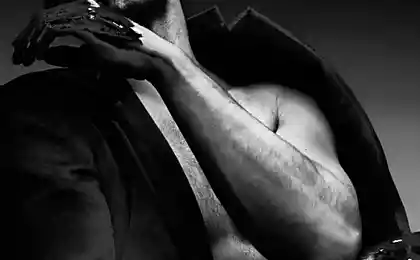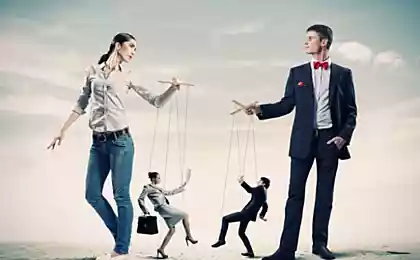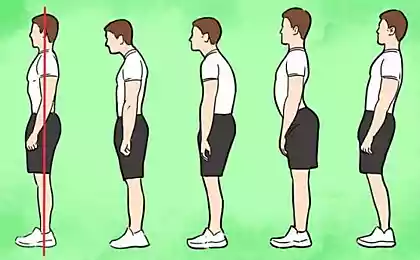830
Posture as a sign VICTIMS
Of course, everyone on the head can accidentally fall brick. But if you do not climb on the construction site without a helmet and walk under the balconies, you will reduce the risk to the statistical error.

Each of us certainly think about personal safety. Of course, to reduce the risk to be attacked there are simple, well-known advice: do not walk alone in the dark distant back streets at night
. But there is a universal rule that not only reduce the risk of being attacked, but also improve your social interaction and confidence. I'm talking about the posture of the victim (including other physical manifestations such as visual pattern, gait, etc..).
Posture as a sign of sacrifice - this is one of the components by which the striker defines a simple target for attacks and attacks (while all the people who fall into the category of "hard target" are simply ignored) among potential victims. Have you ever thought about how the bandits, robbers, etc. choosing a victim? Why does one person can walk all my life - and it will not work no one ever even time to ask, not to mention money. And the other - the mobile phone is stolen, the naedut, stop ... What is the difference?
And not unlike the surface that is difficult to see a fundamental difference, which can be used on their own? The main thing you need to do to protect themselves from bandits - this is becoming a difficult target.
What is "hard target"?
It is difficult to achieve the goal. To achieve that you need to make a much greater effort - the benefits will be obtained. Well, we remember the items that make a person a victim = easy target:
Easy target is not in real time (the main feature);
and, as a consequence, does not notice the surveillance, signs of ritual attacks;
the victim is thinking like a victim and therefore behaves as a victim;
in particular - stoops;
says quietly, vaguely;
no eye contact;
goes uncoordinated, clumsy;
Easy target goes to those places where it is not going to be
and so on.
The main criterion of "difficult targets" - whether the person is in the present tense. Or, in the words of Jeff Thompson (book "The survival rate in the City"), whether the person is aware of the danger threatening it. It's simple: watching the environment in real time, you can notice the danger in advance. The more free attention at your disposal, the faster and more accurate you will be able to do it. Now, answer the question - what state you walk down the street? Remember that just being in the present tense enough free attention will allow you time to observe the approaching danger.
Posture - the selection criteria victim
. Victimology is a science about the behavior of the victim, can explain what guided mugger or rapist when choosing a victim. This science helps to identify the human predisposition to becoming a victim of crime.
Studies have shown that the offender takes an average of seven seconds to assess the potential of the object of attack - his fitness, temperament, etc. The offender observes everything.. Uncertainty glance diffidence movements languid posture, physical disabilities, mental depression, fatigue - everything that will play into his hands. For example, for patients suffering from depression, typical of "dejected posture." Doctors pay attention to the irregularities in the depression of functions such as sleep, appetite, sex drive, and so on. D., But, as a rule, do not see such a bright manifestation of the disease, as the posture.
Of course, this does not mean that criminals geniuses care or super observant people. Just a week workout - and you will also be able to notice these signs.
To find out the main features of the personality of the potential victims were captured on videotape pedestrians. Record was demonstrated prisoners serving a sentence for various crimes. And here's the result. The vast majority of prisoners, who were interviewed separately, chosen from the crowd of the same people who, in their opinion, could become easy prey.
Target: Before reading further, imagine how the attackers choose the victim?
It turned out that the potential victim criminals usually allocate for certain distinguishing features of the motion. This may be their general lack of coordination, clumsiness of gait - too sweeping or mincing. two categories of people were identified:
the so-called "risk group". They can be called Lanky: they do not physically organized, relaxed and unassembled.
and those who hardly in danger of becoming the object of attack. These are confident, as they say, "Come on tailored, tightly stitched" they look and tread confidently.
Task: and again, before you read any further, try to figure out what mistakes allow people "at risk"?
What to do?
Most of these items can be removed and turned into a target complex simple but permanent careful observation of the environment. But what is difficult to do using a single observation, so it is correct posture. First of all it is important to know what kind of behavior can help avoid a collision with the attackers. This question helps to answer the following table:
Features of the victim's behavior, and not the victim
Victim
No victim
Hurried, nervous smile
The calm smile, a confident expression face
Nervous pose
Quiet position
Quiet, myamlyaschy voice
Confident tone
Hands all time in a restless movement
Rare and quiet movement
hands Hunched posture, languid posture
Smart, relaxed and stable posture
Nervous, running around
glance Calm and direct gaze
Lack of coordination, clumsiness of gait (too sweeping or mincing)
Light sports gait, vigor, vigor movements
Let's talk about your posture more. Posture - a habitual posture (vertical posture, the vertical position of the body) at rest and during movement.
In this posture - this is the position of the body, which is regulated unconsciously. The man has only one inherent only his usual posture. Posture is usually associated with bearing, habitual posture, demeanor.
Now it becomes clear why a person, thinking the victim for a long time, becomes haggard posture, clearly showing that he - the victim? Because the human mind constantly sends the right signal. In our case, "I am a victim." Accordingly, it is possible to reflect a bit and come to an interesting conclusion: "If I can not stop being a victim, think like a victim - then maybe I need to start with the posture? And, align, change my mind? »
Nice try, which usually ends with the man forgets about the fact that you need to keep your posture, and returns to stand and move to his usual manner - as a victim. But such thoughts - a good sign, it's a lot better than having no such thoughts.
But back to the posture. Can I change the posture by working it with the body and not the mind and a sense of "sacrifice"? It is possible, but difficult. And a few points should be taken into account for this purpose. Firstly, you need to start not only with the idea "to keep your posture," but also with the corresponding "direct" posture emotions. What is meant? It's very simple - and we say this is Charles Darwin (1880) in his book "Emotions of people and animals»:
"Certain movements and postures (sometimes substantially) can cause the appropriate emotions. ... Take a sad posture, and after some time you will be sad ... Emotions impel the movement, but the movement and evoke emotion."
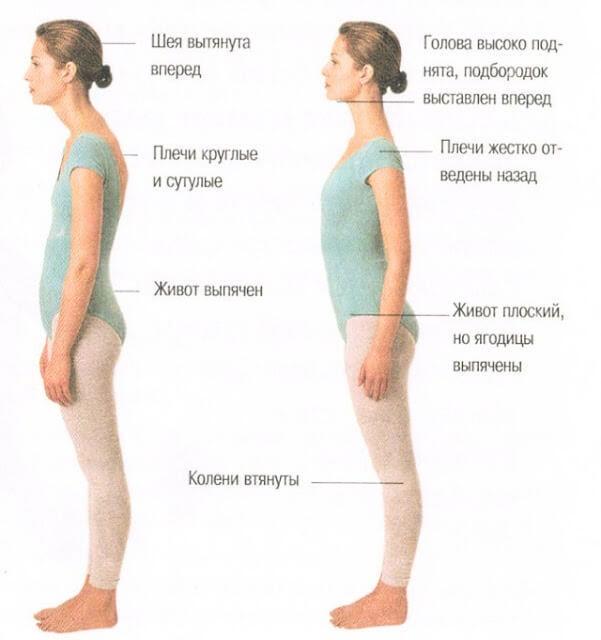
You become a victim also for the reason that, having poor posture is much easier to submit. Yes, that's right, a person with bad posture unconsciously submits to a person with a direct bearing. And this relationship is "sewn up" in his head so deeply that people of this almost never think, but it does not prevent them from acting in accordance with these principles. So, a person who was guilty, automatically tilts his head bowed in respect and subordination, beggars bow their heads to cause pity, etc.

Each of us certainly think about personal safety. Of course, to reduce the risk to be attacked there are simple, well-known advice: do not walk alone in the dark distant back streets at night
. But there is a universal rule that not only reduce the risk of being attacked, but also improve your social interaction and confidence. I'm talking about the posture of the victim (including other physical manifestations such as visual pattern, gait, etc..).
Posture as a sign of sacrifice - this is one of the components by which the striker defines a simple target for attacks and attacks (while all the people who fall into the category of "hard target" are simply ignored) among potential victims. Have you ever thought about how the bandits, robbers, etc. choosing a victim? Why does one person can walk all my life - and it will not work no one ever even time to ask, not to mention money. And the other - the mobile phone is stolen, the naedut, stop ... What is the difference?
And not unlike the surface that is difficult to see a fundamental difference, which can be used on their own? The main thing you need to do to protect themselves from bandits - this is becoming a difficult target.
What is "hard target"?
It is difficult to achieve the goal. To achieve that you need to make a much greater effort - the benefits will be obtained. Well, we remember the items that make a person a victim = easy target:
Easy target is not in real time (the main feature);
and, as a consequence, does not notice the surveillance, signs of ritual attacks;
the victim is thinking like a victim and therefore behaves as a victim;
in particular - stoops;
says quietly, vaguely;
no eye contact;
goes uncoordinated, clumsy;
Easy target goes to those places where it is not going to be
and so on.
The main criterion of "difficult targets" - whether the person is in the present tense. Or, in the words of Jeff Thompson (book "The survival rate in the City"), whether the person is aware of the danger threatening it. It's simple: watching the environment in real time, you can notice the danger in advance. The more free attention at your disposal, the faster and more accurate you will be able to do it. Now, answer the question - what state you walk down the street? Remember that just being in the present tense enough free attention will allow you time to observe the approaching danger.
Posture - the selection criteria victim
. Victimology is a science about the behavior of the victim, can explain what guided mugger or rapist when choosing a victim. This science helps to identify the human predisposition to becoming a victim of crime.
Studies have shown that the offender takes an average of seven seconds to assess the potential of the object of attack - his fitness, temperament, etc. The offender observes everything.. Uncertainty glance diffidence movements languid posture, physical disabilities, mental depression, fatigue - everything that will play into his hands. For example, for patients suffering from depression, typical of "dejected posture." Doctors pay attention to the irregularities in the depression of functions such as sleep, appetite, sex drive, and so on. D., But, as a rule, do not see such a bright manifestation of the disease, as the posture.
Of course, this does not mean that criminals geniuses care or super observant people. Just a week workout - and you will also be able to notice these signs.
To find out the main features of the personality of the potential victims were captured on videotape pedestrians. Record was demonstrated prisoners serving a sentence for various crimes. And here's the result. The vast majority of prisoners, who were interviewed separately, chosen from the crowd of the same people who, in their opinion, could become easy prey.
Target: Before reading further, imagine how the attackers choose the victim?
It turned out that the potential victim criminals usually allocate for certain distinguishing features of the motion. This may be their general lack of coordination, clumsiness of gait - too sweeping or mincing. two categories of people were identified:
the so-called "risk group". They can be called Lanky: they do not physically organized, relaxed and unassembled.
and those who hardly in danger of becoming the object of attack. These are confident, as they say, "Come on tailored, tightly stitched" they look and tread confidently.
Task: and again, before you read any further, try to figure out what mistakes allow people "at risk"?
What to do?
Most of these items can be removed and turned into a target complex simple but permanent careful observation of the environment. But what is difficult to do using a single observation, so it is correct posture. First of all it is important to know what kind of behavior can help avoid a collision with the attackers. This question helps to answer the following table:
Features of the victim's behavior, and not the victim
Victim
No victim
Hurried, nervous smile
The calm smile, a confident expression face
Nervous pose
Quiet position
Quiet, myamlyaschy voice
Confident tone
Hands all time in a restless movement
Rare and quiet movement
hands Hunched posture, languid posture
Smart, relaxed and stable posture
Nervous, running around
glance Calm and direct gaze
Lack of coordination, clumsiness of gait (too sweeping or mincing)
Light sports gait, vigor, vigor movements
Let's talk about your posture more. Posture - a habitual posture (vertical posture, the vertical position of the body) at rest and during movement.
In this posture - this is the position of the body, which is regulated unconsciously. The man has only one inherent only his usual posture. Posture is usually associated with bearing, habitual posture, demeanor.
Now it becomes clear why a person, thinking the victim for a long time, becomes haggard posture, clearly showing that he - the victim? Because the human mind constantly sends the right signal. In our case, "I am a victim." Accordingly, it is possible to reflect a bit and come to an interesting conclusion: "If I can not stop being a victim, think like a victim - then maybe I need to start with the posture? And, align, change my mind? »
Nice try, which usually ends with the man forgets about the fact that you need to keep your posture, and returns to stand and move to his usual manner - as a victim. But such thoughts - a good sign, it's a lot better than having no such thoughts.
But back to the posture. Can I change the posture by working it with the body and not the mind and a sense of "sacrifice"? It is possible, but difficult. And a few points should be taken into account for this purpose. Firstly, you need to start not only with the idea "to keep your posture," but also with the corresponding "direct" posture emotions. What is meant? It's very simple - and we say this is Charles Darwin (1880) in his book "Emotions of people and animals»:
"Certain movements and postures (sometimes substantially) can cause the appropriate emotions. ... Take a sad posture, and after some time you will be sad ... Emotions impel the movement, but the movement and evoke emotion."

You become a victim also for the reason that, having poor posture is much easier to submit. Yes, that's right, a person with bad posture unconsciously submits to a person with a direct bearing. And this relationship is "sewn up" in his head so deeply that people of this almost never think, but it does not prevent them from acting in accordance with these principles. So, a person who was guilty, automatically tilts his head bowed in respect and subordination, beggars bow their heads to cause pity, etc.
Mystery frequency of 432 Hz - how brainwashed people to bypass consciousness
In Bhutan will celebrate the birth of the Prince of the forest planting of 108 000 trees

